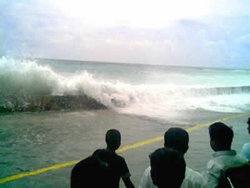Natural Disasters - Tsunami
A tsunami is a massive wave of water which rolls into the
shore area with a height of 15m +. An example of an
earthquake-caused Tsunami is the 2004 Indian Ocean Earthquake.
An example of a landslide-caused Tsunami is the Lituya Bay,
Alaska tsunami.
Tsunami's are caused by displacement of large masses of water
such as an underwater earthquake, volcanic eruption,
landslide, or meteorite impact; most common being the
earthquake.
Tsunami's are caused when the sea floor deforms and vertically
displaces the water on top.
A tsunami is not a normal wave but much bigger. It looks
more like an endlessly onrushing tide that forces it way
around the obstacle.
They are much more dangerous than big waves because they
contain immense energy and propagate at high speeds.
Example:
-
The highest Tsunami was 85m on April 24th, 1771, Japan.
-
The 2004 Indian Ocean Earthquake ranks as the deadliest
tsunami in recorded history.
 |
|
The tsunami that struck Malé in the Maldives on
December 26, 2004. |
 |
|
Schema of a tsunami |
|


0 comment/s:
Post a Comment